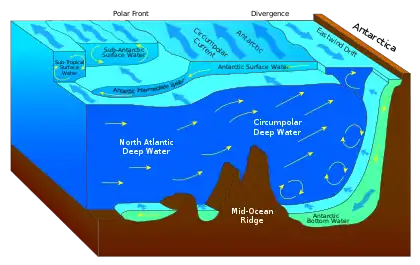In fluid dynamics, the Coriolis–Stokes force is a forcing of the mean flow in a rotating fluid due to interaction of the Coriolis effect and wave-induced Stokes drift. This force acts on water independently of the wind stress.[1]
This force is named after Gaspard-Gustave Coriolis and George Gabriel Stokes, two nineteenth-century scientists. Important initial studies into the effects of the Earth's rotation on the wave motion – and the resulting forcing effects on the mean ocean circulation – were done by Ursell & Deacon (1950), Hasselmann (1970) and Pollard (1970).[1]
The Coriolis–Stokes forcing on the mean circulation in an Eulerian reference frame was first given by Hasselmann (1970):[1]
to be added to the common Coriolis forcing Here is the mean flow velocity in an Eulerian reference frame and is the Stokes drift velocity – provided both are horizontal velocities (perpendicular to ). Further is the fluid density, is the cross product operator, where is the Coriolis parameter (with the Earth's rotation angular speed and the sine of the latitude) and is the unit vector in the vertical upward direction (opposing the Earth's gravity).
Since the Stokes drift velocity is in the wave propagation direction, and is in the vertical direction, the Coriolis–Stokes forcing is perpendicular to the wave propagation direction (i.e. in the direction parallel to the wave crests). In deep water the Stokes drift velocity is with the wave's phase velocity, the wavenumber, the wave amplitude and the vertical coordinate (positive in the upward direction opposing the gravitational acceleration).[1]
See also
Notes
- 1 2 3 4 Polton, J.A.; Lewis, D.M.; Belcher, S.E. (2005), "The role of wave-induced Coriolis–Stokes forcing on the wind-driven mixed layer" (PDF), Journal of Physical Oceanography, 35 (4): 444–457, Bibcode:2005JPO....35..444P, CiteSeerX 10.1.1.482.7543, doi:10.1175/JPO2701.1, archived from the original (PDF) on 2017-08-08, retrieved 2009-03-31
References
- Hasselmann, K. (1970), "Wave‐driven inertial oscillations", Geophysical Fluid Dynamics, 1 (3–4): 463–502, Bibcode:1970GApFD...1..463H, doi:10.1080/03091927009365783
- Leibovich, S. (1980), "On wave–current interaction theories of Langmuir circulations", Journal of Fluid Mechanics, 99 (4): 715–724, Bibcode:1980JFM....99..715L, doi:10.1017/S0022112080000857, S2CID 14996095
- Pollard, R.T. (1970), "Surface waves with rotation: An exact solution", Journal of Geophysical Research, 75 (30): 5895–5898, Bibcode:1970JGR....75.5895P, doi:10.1029/JC075i030p05895
- Ursell, F.; Deacon, G.E.R. (1950), "On the theoretical form of ocean swell on a rotating Earth", Monthly Notices of the Royal Astronomical Society, 6 (Geophysical Supplement): 1–8, Bibcode:1950GeoJ....6....1U, doi:10.1111/j.1365-246X.1950.tb02968.x

